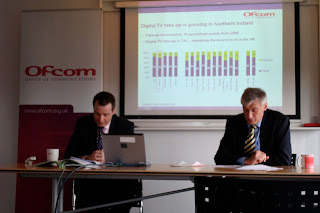
The launch of Ofcom’s Nations & Regions Communication’s Market Report has become an annual event. AiB mentioned it back in 2006. It’s basically the results of a huge survey carried out across the UK (backed up by figures from various Ofcom stakeholders – telcos and broadcasters etc) looking at television, radio, telecoms and (new for this year) a section on converged communications.
It’s kind of the Wisden Cricketers’ Almanac for media and comms anoraks.
For their 2008 report, nearly six thousand people were interviewed across the UK in January and February, with 629 surveyed in Northern Ireland. The analysis is published in four parts – England, Scotland, Wales and Northern Ireland. The NI report was launched by Ofcom NI in their shiny white and friendly offices in Belfast’s Gasworks on Thursday morning.

That’s Denis Wolinski (Director of Ofcom NI) on the right, the only one in the room with a Manchester United mug – he was pleased with the previous night’s result in Moscow!
Now Northern Ireland might be small, but it’s not uniform in its tastes and can be sliced and diced in so many ways. So for the first time there wasn’t just a rural/urban comparison for the NI stats. From this year it includes figures for east/west of the Bann (both further divided into urban/rural).
And then there are specific figures for Londonderry/Derry and Belfast as well as Small towns (Enniskillen, Omagh, Newry, Dungannon, Armagh, Ballycastle, Cookstown, Coleraine) and Border areas (Derry, Newry, Strabane, Portstewart, Warrenpoint). Forgive me for thinking Newry was a small city rather than a small town!
There’s enough in the report for a series of blog entries, so I’ll eek it out and bore you over the next few days! (Some of the raw only slightly processed data is also available from Ofcom for download and further analysis.)
But a few facts and figures to whet your appetite:
On average, people in Northern Ireland watch less TV than the rest of the UK. And our viewing of the main five terrestrial TV channels is “not haemorrhaging like the rest of the UK regions”.
We’re the Luddites of digital radio with the lowest awareness of DAB, lowest ownership of DAB radios, and the lowest number of people who’ve ever listened to radio by any digital means (DAB, cable, Freeview, online, etc).
With highest speeds and DSL availability in urban areas, broadband take-up is actually strongest in rural areas. And if you have broadband, use of wireless hubs is particularly popular in Northern Ireland with particular peaks in the rural east and border areas. Though Swansea, Yorkshire, Newcastle upon Tyne and the rural east/south east of England can top that.
Inadvertent mobile roaming across the border is still a problem, and very few people affected are aware of the new tariffs that O2 and 3 have introduced to address the issue. If you live in Belfast you’re twice as likely to know about the new tariffs than someone living in a border region.
3G covers only 44% of NI – yet take-up of 3G handsets equals the rest of the UK (with an average of 90% 3G coverage).
Northern Ireland has a higher than average use of mobile phones to listen to audio content (such as radio, MP3s or podcasts). Derry is particularly high, though behind the audiophiles in Liverpool and Birmingham.
I’d never heard of the term media stacking before seeing the report. Basically, using two or more different types of media at the same time. Like rubbing your tummy and patting your head. Perhaps, watching TV and talking on a mobile or surfing the internet.

And the Ofcom random stat of the year ... as of January 2008 there were over 6,000 Wikipedia articles in Irish and over 2,000 in Ulster Scots. Trivial Pursuit, here we come.
Two years ago it felt like Northern Ireland was on the wrong side of the digital divide. But the 2008 figures offer some hope. I’ve update the quick summary table from the blog post two years ago to give some kind of rough comparison.

We still lag behind, but not by as much.
See later more detailed posts covering radio, TV, mobile & fixed telecoms, broadband and online.
6 comments:
Very interesting post Alan. On the point about DAB, if Ofcom would give the transmitters a little more power my Mum would be more than happy to use her DAB radio. Unfortunately where we live as soon as any sort of breeze picks up the signal goes.
You're only encouraging me to post the follow-ups looking at some of the areas in a bit more detail.
They'll all be blaming you!
Note that it's two different sets of transmitters for the local commercial multiplex and the BBC national stations one. Similar % household stats, but slightly different footprints. So as I understand it, you could get one and not the other.
The figure for weekly income in the 2008 report equates to an annual salary of £30,000 (for the NI figure) which would suggest that they surveyed users with above average income. Or is this for household income rather than individual income?
Yes - just looked it up. Weekly household income. (Sourced from Office of National Statistics, Family Spending, 2007)
But surely the real question - NI - nation or region?
Doesn't devolution sway the swingometer over to the side that says nation.
And if Yorkshire devolved, it would have to switch from being region to nation.
A question. London - nation or region?
Post a Comment